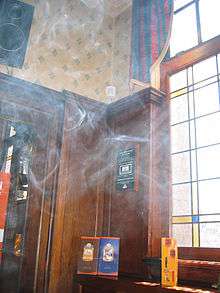Olympic Airways Flight 417
 The SX-OAB Boeing 747 of Olympic Airways, the aircraft involved in the incident. | |
| Occurrence summary | |
|---|---|
| Date | 4 January 1998 |
| Summary | Fatal reaction to secondhand smoke |
| Site |
In flight between Athens, Greece, and New York, New York, United States 0 |
| Passengers | 232 |
| Crew | 12 |
| Fatalities | 1 |
| Injuries (non-fatal) | 0 |
| Survivors | 243 |
| Aircraft type | Boeing 747-284B |
| Operator | Olympic Airways |
| Registration | SX-OAB |
| Flight origin | Athens, Greece |
| Destination | John F. Kennedy Airport, New York, United States |
On 4 January 1998, Dr Abid Hanson,[1] a passenger on Olympic Airways Flight 417 from Cairo, Egypt, via Athens, Greece, to New York City in the United States, died following exposure to secondhand smoke.[2]
Hanson, who had a "history of recurrent anaphylactic reactions" and sensitivity to secondhand smoke, had requested a non-smoking seat. When the family boarded the Boeing 747 aircraft[3] in Athens, the people found that the assigned seats were three rows ahead of the economy-class smoking area; there was no partition between the smoking and non-smoking section. The family repeatedly requested a seat further away from the smoking section but the flight attendant, Maria Leptourgou, would not move the passenger to any of the 11 other unoccupied seats on the aircraft. The passenger felt a reaction to the smoke and died several hours later despite his doctor's aid.[3]
Background

Smoking on international flights was already seen as a safety issue by the International Civil Aviation Organization's aviation medicine section, which had sought an outright ban by 1996.[4]
Legal case
The case resulted in the Olympic Airways v. Hanson, 540 U.S. 644 (2004) case in the Supreme Court of the United States. Before the case reached the Supreme Court, the lower courts had decided as follows:
The District Court found petitioner liable for Dr. Hanson’s death, and the Ninth Circuit affirmed, concluding that, under the definition in Air France v. Saks, 470 U.S. 392 (1985)] of “accident,” the flight attendant’s refusal to re-seat Dr. Hanson was clearly external to him, and unexpected and un-usual in light of industry standards, Olympic policy, and the simple nature of the requested accommodation.[5]
On initial appeal, a three-judge panel of the United States Court of Appeals for the Ninth Circuit unanimously affirmed the finding of the District Court that Leptourgou's actions not only met the definition of “accident” under Article 17 of the Warsaw Convention, but also rose to the level of being “wilful misconduct” under Article 25; by passing that threshold, it removed a $75,000 cap on damages.[3]
The Supreme Court upheld the Court of Appeals award of USD$ 700,000 in compensatory damages against Olympic Airways, holding that: "the conduct here constitutes an 'accident' under Article 17 of the Warsaw Convention. Accordingly, the judgment of the Court of Appeals is affirmed."[6]
See also
References
- ↑ Lithwick, Dahlia. "The Accidental Tourist." Slate. Wednesday 12 November 2003. Retrieved on 4 July 2009.
- ↑ Supreme Court brief
- 1 2 3 Husain v. Olympic Airways (Archive), 316 F.3d 829 (9th Cir. 2002)
- ↑ Smoking restrictions on international passenger flights
- ↑ Court Syllabus
- ↑ Decision of the USSC